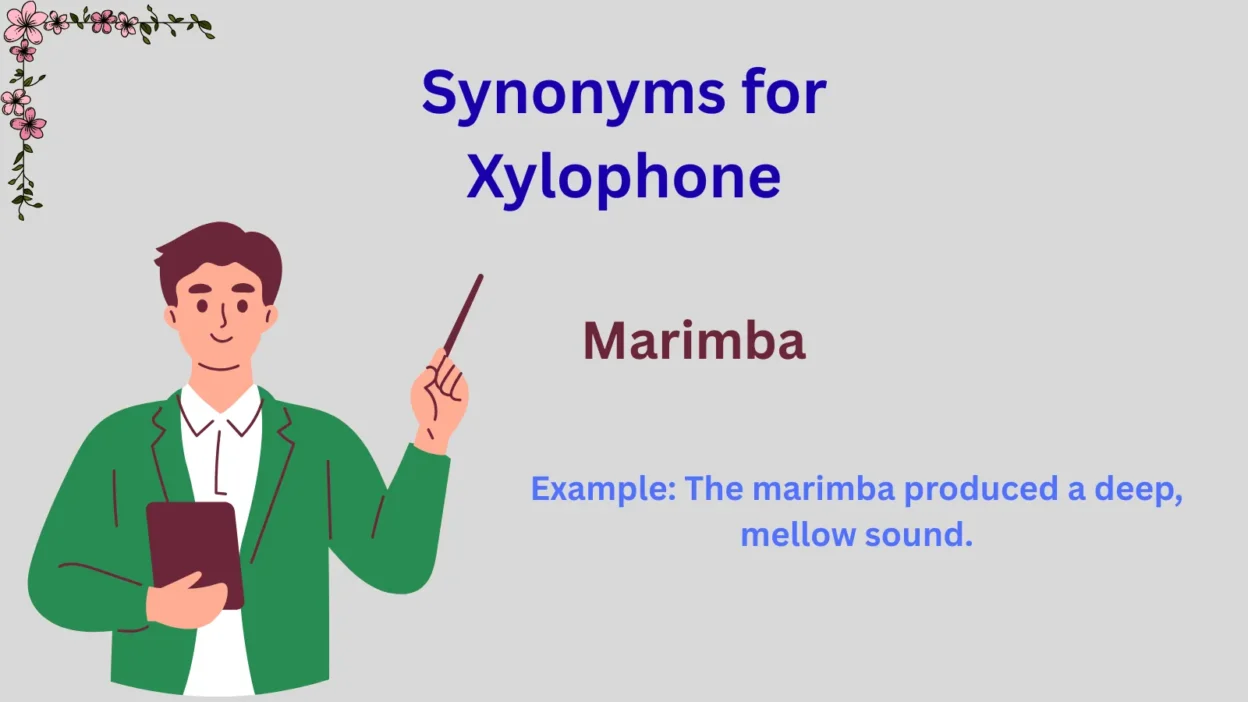Xylophone Synonyms, such as marimba, vibraphone, and glockenspiel, describe percussion instruments that create sound through tuned bars struck by mallets. For example, “She played the marimba beautifully during the concert,” or “The glockenspiel added a bright tone to the orchestra.” Each term highlights a different kind of bar-based percussion instrument with its own sound and cultural background.
If you’re writing about music, sound design, or performance, choosing the right synonym for xylophone helps you express tone, texture, and musical emotion more vividly.
In this guide, you’ll explore the meaning, context, and example sentence for each synonym, helping you pick the perfect word for your creative, educational, or musical writing.
Understanding the Word “Xylophone”
The word “xylophone” comes from the Greek roots xylon (wood) and phone (sound), meaning “wood sound.”
A xylophone is a percussion instrument made up of wooden bars that produce musical notes when struck with mallets. It’s known for its bright, lively tone and is often used in orchestras, classrooms, and world music.
For example:
- The child learned to play simple melodies on a xylophone.
- The composer used a xylophone to add sparkle to the symphony.
Because the word refers to both a specific instrument and a family of similar instruments, many synonyms reflect differences in material, tone, or cultural origin.
30 Synonyms of “Xylophone” with Meanings, Examples, and Usage Tips
1. Marimba
Meaning: A large wooden percussion instrument with resonators.
Example: The marimba produced a deep, mellow sound.
When to Use: Use for Latin or orchestral music with a warm tone.
2. Vibraphone
Meaning: A metal-bar percussion instrument with motorized vibrato.
Example: The vibraphone added smooth jazz textures to the piece.
When to Use: Perfect for jazz, modern, or fusion compositions.
3. Glockenspiel
Meaning: A metal instrument with bright, bell-like tones.
Example: The glockenspiel sparkled in the background of the melody.
When to Use: For light, cheerful, or children’s music.
4. Metallophone
Meaning: General term for instruments with metal bars struck by mallets.
Example: Balinese music often features metallophones.
When to Use: Academic or world-music contexts.
5. Balafon
Meaning: A West African xylophone made from wooden bars and gourds.
Example: The balafon’s earthy tone carried through the festival air.
When to Use: Cultural, African, or ethnomusicological writing.
6. Lithophone
Meaning: An ancient instrument made from tuned stones.
Example: The museum displayed a lithophone used in rituals.
When to Use: Historical or archaeological discussions.
7. Resonaphone
Meaning: A variant percussion instrument that uses resonant tubes.
Example: The resonaphone’s echo filled the concert hall.
When to Use: For describing experimental or hybrid instruments.
8. Tongue Drum
Meaning: A percussion instrument with cut “tongues” that produce notes.
Example: He played the tongue drum to create meditative sounds.
When to Use: Spiritual, modern, or relaxation music.
9. Kalimba
Meaning: African thumb piano made of metal keys on a wooden board.
Example: The kalimba’s gentle chime added a soothing rhythm.
When to Use: For world music, folk, or minimalist writing.
10. Carillon
Meaning: Tower instrument of tuned bells played with a keyboard.
Example: The carillon rang across the city square.
When to Use: Church, ceremonial, or historical contexts.
11. Chime Bars
Meaning: Simple tuned bars played individually or in sets.
Example: Children practiced rhythm on colorful chime bars.
When to Use: Music education or early learning contexts.
12. Tubular Bells
Meaning: Long metal tubes producing resonant, bell-like sounds.
Example: Tubular bells marked the climax of the symphony.
When to Use: Orchestral or dramatic writing.
13. Bar Chime
Meaning: Handheld or mounted percussion producing shimmering tones.
Example: The bar chime added sparkle to the ambient track.
When to Use: Studio, new-age, or film music contexts.
14. Temple Blocks
Meaning: Wooden percussion blocks of varying pitches.
Example: The drummer struck temple blocks during the ritual performance.
When to Use: Religious, ceremonial, or Asian music contexts.
15. Agung a Tamlang
Meaning: Filipino bamboo xylophone.
Example: The agung a tamlang reflected Filipino musical heritage.
When to Use: Ethnic or cultural music discussions.
16. Roneat Ek
Meaning: Cambodian wooden xylophone with bright tones.
Example: The roneat ek led the Pinpeat ensemble.
When to Use: Southeast Asian traditional music contexts.
17. Ranat Ek
Meaning: Thai xylophone with 21 wooden bars.
Example: The ranat ek created lively rhythms during the performance.
When to Use: Cultural, traditional, or ethnographic writing.
18. Gendér
Meaning: Indonesian metallophone used in gamelan orchestras.
Example: The gendér played intricate melodies throughout the piece.
When to Use: Describing Indonesian or Balinese gamelan music.
19. Saron
Meaning: Javanese metallophone with thick bronze bars.
Example: The saron carried the melody in the gamelan ensemble.
When to Use: World music or performance analysis.
20. Xylorimba
Meaning: A hybrid between xylophone and marimba.
Example: The xylorimba provided a wide tonal range.
When to Use: Orchestral or modern compositions.
21. Aluphones
Meaning: Metal percussion instruments with varied tuning.
Example: The aluphones produced shimmering metallic tones.
When to Use: Experimental or avant-garde music.
22. Bell Lyre
Meaning: Marching-band instrument shaped like a lyre.
Example: The bell lyre gleamed as the parade passed by.
When to Use: Marching bands or ceremonial contexts.
23. Toy Xylophone
Meaning: Simplified children’s version of the instrument.
Example: The toddler tapped happily on the toy xylophone.
When to Use: Early learning or informal writing.
24. Idiophone
Meaning: Class of instruments producing sound by vibration of the material itself.
Example: The xylophone belongs to the idiophone family.
When to Use: Music theory or academic contexts.
25. Steelpan
Meaning: Metal percussion from Trinidad and Tobago.
Example: The steelpan created tropical melodies.
When to Use: Caribbean or festive music.
26. Celesta
Meaning: Keyboard instrument producing delicate, bell-like sounds.
Example: The celesta sparkled in Tchaikovsky’s “Nutcracker.”
When to Use: Classical or fairy-tale-like tone.
27. Bell Plates
Meaning: Flat metal plates producing resonant tones when struck.
Example: The bell plates added depth to the percussion section.
When to Use: Contemporary or symphonic compositions.
28. Tone Bar
Meaning: Single metal or wooden bar tuned to a pitch.
Example: The musician struck each tone bar precisely.
When to Use: Educational or mechanical writing.
29. Bamboo Marimba
Meaning: Marimba variation using bamboo resonators.
Example: The bamboo marimba gave a rustic tone to the folk song.
When to Use: Ethnic, folk, or organic music.
30. Mallet Percussion
Meaning: General term for all instruments struck with mallets.
Example: Mallet percussion formed the heart of the ensemble.
When to Use: Broad musical or orchestral descriptions.
Choosing the Right Synonym for “Xylophone”
Selecting the right synonym depends on your context and sound goal:
- Orchestral/Classical: marimba, vibraphone, glockenspiel, tubular bells
- Cultural/World Music: balafon, roneat ek, gendér, ranat ek
- Modern/Jazz: vibraphone, xylorimba, aluphones
- Educational/Casual: chime bars, toy xylophone, tone bar
- Experimental/Creative: metallophone, lithophone, bell plates
Cultural Tip:
In Western orchestras, the xylophone is often bright and percussive, while the marimba is deeper and warmer.
In Asian and African traditions, versions like balafon or ranat ek carry cultural heritage and unique tuning systems—choosing the right synonym connects your writing to its cultural roots.
Conclusion :
Xylophone Synonyms reveal a world of musical expression, from the shimmering glockenspiel to the deep, resonant marimba. Each carries its own tone, history, and emotion.
Choosing the right term helps you set the soundscape of your writing—whether you’re describing classical compositions, folk rhythms, or educational settings.
Mastering these alternatives makes your language as vibrant and expressive as the music itself.



